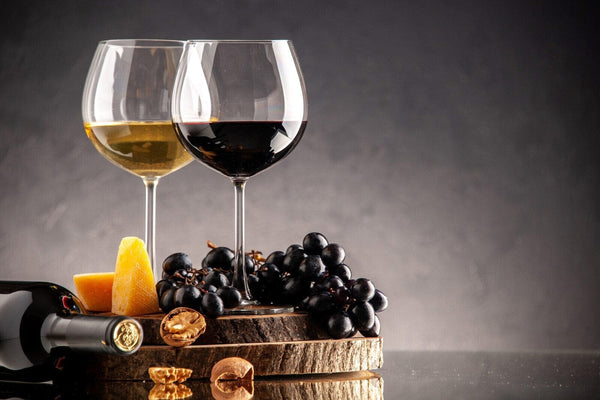Filtered vs Unfiltered Wine: Which is Better?

Unfiltered wines are becoming increasingly popular on wine lists and in online wine stores like Bottle Barn. By avoiding the clarification and filtration process, these low-intervention wines retain yeast and other naturally occurring particles. Lots of examples exist from winegrowing regions worldwide, like the 2021 Mas de Gourgonnier Les Baux de Provence Red, the 2021 Descendientes de J. Palacios Bierzo Petalos, and the 2022 Lotis Wines Eagle Point Ranch Counoise from Mendocino.
A lot of the attention to unfiltered wines can be linked to the "natural wine" movement; however, many wineries, such as Robert Mondavi, have been making unfiltered wines for decades. As the natural wine movement gains momentum, though, unfiltered and unclarified wines are gaining ground. Be aware, while not all will display a cloudy appearance or yeast sediment, many will showcase these characteristics.
Reasons For the Popularity of Unfiltered Wine
Unfiltered wine can be just as enjoyable as any other wine. Both winemakers and consumers argue that the filtration and clarification process can diminish the intensity of natural flavors and aromas, some preferring to intervene as little as possible. For example, the presence of yeast in unfiltered wine may provide a unique and different tasting experience. So, when you purchase wine online and find a bottle of unfiltered wine, try letting the yeast settle at the bottom before pouring the first glass. Then, swirl the yeast to mix it with the remaining wine and observe how the drink changes.
What Does Wine Filtration Involve?
--Removing Sediment
After fermentation, yeast, grape must, and other floating particles give the wine a cloudy appearance. In most cases, the wine is filtered to remove sediment, both for aesthetic reasons and to achieve the desired texture.
--Preservation and Quality
Leaving particles in the wine can increase the risk of spoilage. Bacteria will adhere to the sediment and dead yeast cells, which, although not harmful, may accelerate wine decomposition. Hence, understandably, this is a risk many winemakers choose not to take.
--The Filtration Process
Winemakers use filters, screens, and sieves to remove sediment from the wine. They may also rack the wine, allowing the yeast to settle at the bottom of the tank before transferring the wine to another tank without incorporating the yeast layer.
Wine clarification involves removing suspended particles to achieve a fully clear wine. Many wineries use animal by-products, such as egg whites or fish bladder, to clarify their wines. These proteins bind to unwanted particles, precipitating them to the bottom of the tank, where they are easily removed.
By contrast, some wineries use vegan alternatives, like bentonite clay, to clarify their wines. Remember that wineries are not required to disclose their clarification or filtration methods on labels, websites, or technical sheets. Nonetheless, to help you out, you will find a hand-curated collection of vegan friendly wines, many unfiltered, at Bottle Barn!
Benefits of Unfiltered Wine
Unfiltered wine offers wine lovers a unique and authentic tasting experience. By retaining naturally occurring yeasts and suspended solids, such wines will offer more intense and distinctive flavors and aromas. Each sip becomes a more complex sensory journey, where you will note nuances not found in filtered wines.
Unfiltered wine also evokes a deep connection to artisanal winemaking. During most of history, wines were generally unfiltered and unclarified. By opting for low-intervention wines, you will have a closer link to traditional production methods, lending value to the enhanced authenticity of each bottle. Unfiltered wine can be a way to appreciate this ancient beverage in its purest form and respect the diversity and individuality of each vintage.
How to Enjoy an Unfiltered Wine
After receiving your online wine delivery, to get the most out of unfiltered wine, be sure to decant the bottle before serving. Allowing the yeast to settle at the bottom of a decanter helps separate the clear wine. Then, for an even more interesting experience, you can swirl any remaining yeast cells before serving, allowing this to release aromas and flavors you won’t find in clarified wine.
With their distinctive character and more pronounced flavors, unfiltered wines are an excellent option for pairing with food. Their richness and complexity make them ideal for dishes with intense flavors, such as aged cheeses, grilled meats, stews, and spiced dishes. For example, inside that red wine bottle, the combination of earthy and fruity flavors in the unfiltered wine will enhance the flavors of a variety of foods, creating an exceptional culinary experience.
The popularity of unfiltered wines continues to grow as more consumers seek an authentic and low-intervention wine experience. Over the past decade, this trend has helped change conventional perception of wine, opening new possibilities and opportunities in the world of modern wine.
Please let us know what you think about unfiltered and natural wines. Leave us a comment below now!


















Leave a comment